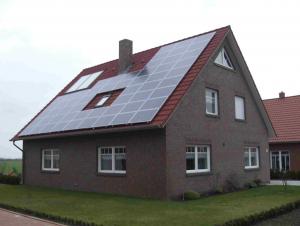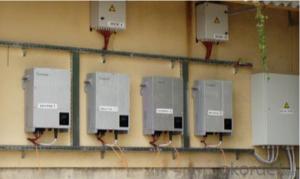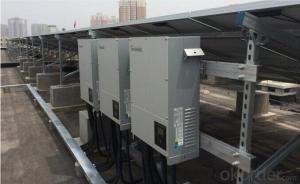Grid Connected Solar Inverter 4000-6000UE
- Loading Port:
- Shekou
- Payment Terms:
- TT or LC
- Min Order Qty:
- 10 pc
- Supply Capability:
- 10000 pc/month
OKorder Service Pledge
OKorder Financial Service
You Might Also Like
Grid Connected Solar Inverter 4000-6000UE
Tri-power excellent inverter for small residential and commercial projects
DC input voltage up to 800V
Maximum efficiency of 97.9%
Internal DC switch
Transformerless
Compact design
Multi MPP controller
MTL-string
Bluetooth/ RF technology/ WiFi
Sound control
Easy installation
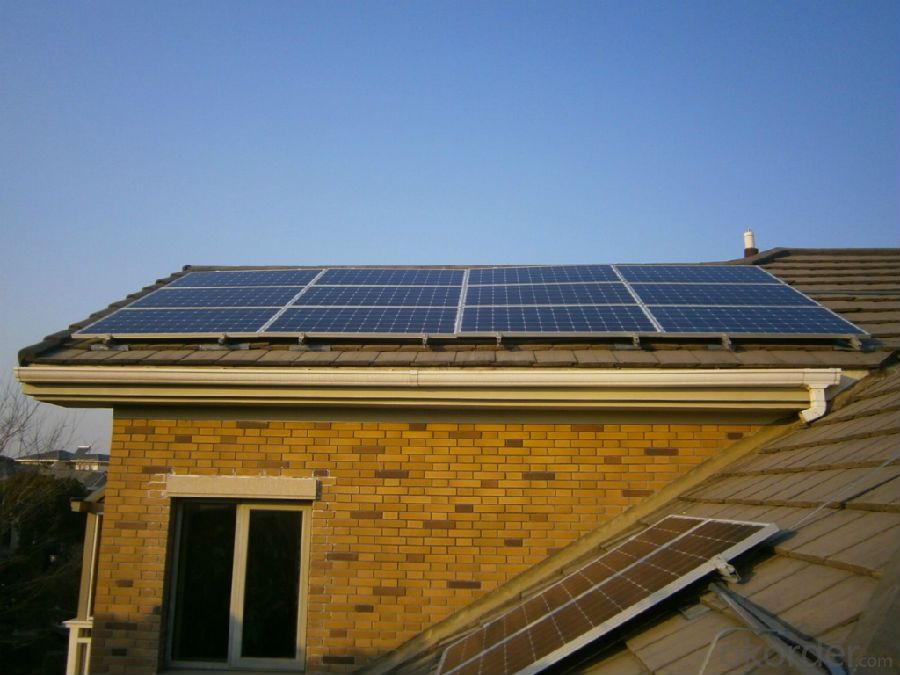
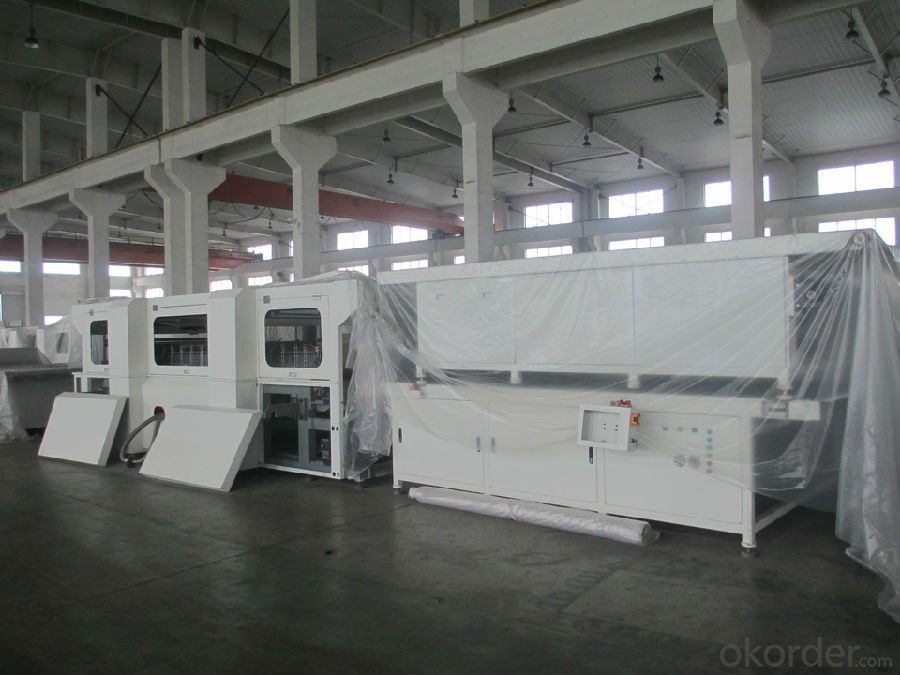
4000UE | 5000UE | 6000UE | |
| Inputdata | |||
| Max.DCpower | 4200W | 5200W | 6300W |
| Max. DC voltage | 800V | 800V | 800V |
| Start Voltage | 150V | 150V | 150V |
| PV voltage range | 140V-800V | 140V-800V | 140V-800V |
| MPP voltage range /Nominal voltage | 200V-800V/ 580V | 200V-800V/ 580V | 200V-800V/ 580V |
| Full load DC voltage range | 250V-750V | 300V-750V | 350V-750V |
| Max. input current / per string | 9A/9A | 9A/9A | 10A/10A |
| Number of independent MPP trackers/strings per MPP tracker | 2/1 | 2/1 | 2/1 |
Output (AC) |
| Rated AC output power | 4000W | 5000W | 6000W |
| Max. AC apparent power | 4000VA | 5000VA | 6000VA |
| Max. output current | 6.4A | 7.9A | 9.3A |
| Max. short-circuit current | 20A | 20A | 20A |
| AC nominal voltage ;range | 230/400V;184-275V | 230/400V;184-275V | 230/400V;184-275V |
| AC grid frequency; range | 50Hz,60Hz; ±5Hz | 50Hz,60Hz; ±5Hz | 50Hz,60Hz; ±5Hz |
| Displacement power factor configurable | 0.9leading-0.9lagging | 0.9leading-0.9lagging | 0.9leading-0.9lagging |
| THDI | <3% | <3% | <3% |
| Grid connection type | 3/N/PE,3W+PE(opt) | 3/N/PE,3W+PE(opt) | 3/N/PE,3W+PE(opt) |
| Efficiency | |||
Max.efficiency | 97% | 97.4% | 97.5% |
| Features | |||
DC connection AC connection Display | H4/MC4(opt) Screw terminal LCD opt/opt/opt | H4/MC4(opt) Screw terminal LCD yes/yes/ opt/opt/opt yes/opt | H4/MC4(opt) Screw terminal LCD yes/yes/ opt/opt/opt yes/opt |
| Generaldata | |||
Dimensions(W/H/D) in mm | 433/566/195 | 433/566/195 31.1KG | 433/566/195 31.1KG |
| Certificates and ApprovalsCE, VDE0126-1-1, VDE-AR-N4105, IEC 62109-1/-2, C-tick, AS/NZS 3100, AS4777, EN61000-6-2 , EN61000-6-3, IEC61727, IEC62116, G83, EN50438 |
- Q:Can a solar inverter be used with a solar-powered remote monitoring system?
- Yes, a solar inverter can be used with a solar-powered remote monitoring system. The solar inverter is responsible for converting the DC (direct current) electricity generated by the solar panels into AC (alternating current) electricity that can be used to power various devices, including the remote monitoring system. This allows the system to operate efficiently and effectively, ensuring that the solar-powered remote monitoring system functions properly and provides real-time data monitoring.
- Q:Can a solar inverter be used with a hybrid solar power system?
- Yes, a solar inverter can be used with a hybrid solar power system. A hybrid solar power system combines solar energy with other sources such as batteries or the electrical grid. The solar inverter is responsible for converting the direct current (DC) generated by the solar panels into alternating current (AC) that can be used to power household appliances or fed back into the grid. It plays a crucial role in ensuring the compatibility and efficient operation of the hybrid solar power system.
- Q:How does a solar inverter handle variations in solar panel cleanliness?
- A solar inverter does not directly handle variations in solar panel cleanliness. However, a decrease in solar panel cleanliness can lead to a decrease in the overall energy output of the solar system. This reduced energy input is then processed by the solar inverter, which converts it into usable electricity. Therefore, while a solar inverter itself does not handle the cleanliness of solar panels, it indirectly adapts to variations by adjusting the energy conversion process based on the input it receives from the panels.
- Q:Can a solar inverter be used with a solar-powered water pump?
- Yes, a solar inverter can be used with a solar-powered water pump. A solar inverter converts the direct current (DC) generated by solar panels into alternating current (AC) that can be used to power various electrical devices, including water pumps. This allows the solar panels to directly power the water pump, making it an efficient and sustainable solution for water pumping applications.
- Q:Are solar inverters weatherproof?
- Yes, solar inverters are weatherproof. They are designed to withstand various weather conditions including rain, snow, and extreme temperatures. The enclosures of solar inverters are typically made of durable materials that provide protection against moisture and other environmental factors.
- Q:Can a solar inverter be used in low light conditions?
- Yes, a solar inverter can be used in low light conditions. However, the efficiency of the solar inverter decreases as the amount of available sunlight decreases. Therefore, it may not be as effective in converting solar energy into usable electricity in comparison to bright sunny conditions.
- Q:Can a solar inverter be used with a time-of-use electricity tariff?
- Yes, a solar inverter can be used with a time-of-use electricity tariff. A solar inverter is responsible for converting the direct current (DC) energy produced by solar panels into alternating current (AC) electricity that can be used in homes or businesses. By connecting the solar inverter to a time-of-use electricity tariff, users can take advantage of different electricity rates at different times of the day. This allows them to maximize their solar energy consumption during off-peak hours when electricity rates are lower and minimize their consumption during peak hours when rates are higher.
- Q:What is the lifespan of the capacitors in a solar inverter?
- The lifespan of capacitors in a solar inverter can vary depending on several factors such as the quality of the capacitors, the operating conditions, and the overall design of the inverter. However, on average, high-quality capacitors in a well-designed solar inverter can have a lifespan of around 10 to 15 years. Regular maintenance and proper usage can help extend the lifespan of the capacitors in a solar inverter.
- Q:How does a solar inverter handle voltage regulation during sudden load changes?
- A solar inverter handles voltage regulation during sudden load changes by continuously monitoring the voltage and current outputs from the solar panels. When there is a sudden increase or decrease in the load, the inverter adjusts its power output accordingly to maintain a stable and consistent voltage level. This is achieved through a combination of control algorithms and power electronics within the inverter, ensuring that the voltage remains within an acceptable range to meet the demands of the load.
- Q:Can a solar inverter be used in a mobile or portable solar system?
- Yes, a solar inverter can be used in a mobile or portable solar system. In fact, portable solar systems often include solar inverters to convert the direct current (DC) power generated by solar panels into alternating current (AC) power that can be used to run electrical devices or charge batteries. This allows for the convenience of using solar energy on the go, making it ideal for camping, outdoor activities, and emergency power needs.
1. Manufacturer Overview |
|
|---|---|
| Location | |
| Year Established | |
| Annual Output Value | |
| Main Markets | |
| Company Certifications | |
2. Manufacturer Certificates |
|
|---|---|
| a) Certification Name | |
| Range | |
| Reference | |
| Validity Period | |
3. Manufacturer Capability |
|
|---|---|
| a)Trade Capacity | |
| Nearest Port | |
| Export Percentage | |
| No.of Employees in Trade Department | |
| Language Spoken: | |
| b)Factory Information | |
| Factory Size: | |
| No. of Production Lines | |
| Contract Manufacturing | |
| Product Price Range | |
Send your message to us
Grid Connected Solar Inverter 4000-6000UE
- Loading Port:
- Shekou
- Payment Terms:
- TT or LC
- Min Order Qty:
- 10 pc
- Supply Capability:
- 10000 pc/month
OKorder Service Pledge
OKorder Financial Service
Similar products
New products
Hot products
Hot Searches
Related keywords


